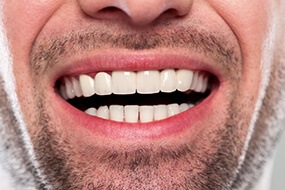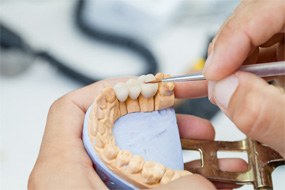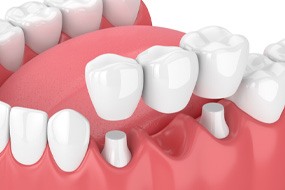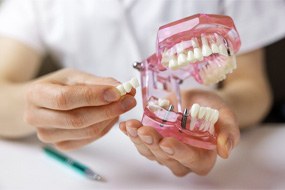Dental Bridges – Hutchinson, KS
Say “Goodbye!” to the Gaps in Your Smile
 If you are missing any teeth and are committed to maintaining good oral hygiene practices, then you may be a good candidate for dental bridges in Hutchinson. A bridge is the natural solution for filling the space left in the mouth by missing teeth, and it can not only connect an altered bite but improve your chewing ability and speech as well. Without a bridge, the space that missing teeth leave can cause the surrounding teeth to drift out of position and leave the gums and teeth more susceptible to decay. To learn more about how to best fight your tooth loss problem, give our office a call and make an appointment with Dr. Ringler today!
If you are missing any teeth and are committed to maintaining good oral hygiene practices, then you may be a good candidate for dental bridges in Hutchinson. A bridge is the natural solution for filling the space left in the mouth by missing teeth, and it can not only connect an altered bite but improve your chewing ability and speech as well. Without a bridge, the space that missing teeth leave can cause the surrounding teeth to drift out of position and leave the gums and teeth more susceptible to decay. To learn more about how to best fight your tooth loss problem, give our office a call and make an appointment with Dr. Ringler today!
What is a Dental Bridge?
 A bridge is a dental appliance that replaces the space left by one or more natural missing teeth. It essentially “bridges” the space between two teeth. The non-removable device consists of three units: a pontic (false tooth) that is fused between two crowns that are cemented to abutment teeth.
A bridge is a dental appliance that replaces the space left by one or more natural missing teeth. It essentially “bridges” the space between two teeth. The non-removable device consists of three units: a pontic (false tooth) that is fused between two crowns that are cemented to abutment teeth.
Dental bridges are often used to:
- Restore your smile
- Fill the space left by missing teeth
- Maintain facial shape
- Prevent remaining teeth from drifting
- Restore your speaking and chewing abilities
- Upgrade from a removable partial denture
Types of Dental Bridges
 During your consultation, Dr. Ringler will conduct a detailed examination of your mouth and ask about your smile goals to determine whether or not this option is right for you. He’ll also ask about your medical and oral health history. Based on your discussion, he’ll recommend one of the following:
During your consultation, Dr. Ringler will conduct a detailed examination of your mouth and ask about your smile goals to determine whether or not this option is right for you. He’ll also ask about your medical and oral health history. Based on your discussion, he’ll recommend one of the following:

Traditional Bridge
A traditional bridge is the most popular way to replace one or more consecutive missing teeth. The device is anchored to your mouth crowns. Of course, it’s important to note that this option will require the alteration of your natural teeth to replace the missing ones.
Implant Bridge
Another great option to consider are implant bridges, which are secured to your mouth using two dental implants instead of crowns. They’re placed on either side of the gap in your smile. Once they’ve fused with the jawbone, we’ll be able to attach the bridge to the implants to complete your smile. Best of all, this treatment doesn’t require the alteration of your existing teeth.The Benefits of Dental Bridges
 By choosing to get a dental bridge in Hutchinson, you can expect to enjoy a wide range of benefits, including:
By choosing to get a dental bridge in Hutchinson, you can expect to enjoy a wide range of benefits, including:
- Maintained alignment of your existing teeth
- Improved oral health
- Easier maintenance
- Jawbone preservation with implant bridges
- Long-lasting results (up to 15 years with a traditional bridge and over 35 with implant-retained)
- Natural-looking appearance
Dental Bridges FAQs
 Dental bridges in Hutchinson have been the go-to solution to treat consecutive tooth loss for decades. We understand you probably have a few questions before you’re ready to commit to one. Your dentist will explain everything during your initial consultation. While you wait for your appointment, here are the answers to the most frequently asked questions about dental bridges.
Dental bridges in Hutchinson have been the go-to solution to treat consecutive tooth loss for decades. We understand you probably have a few questions before you’re ready to commit to one. Your dentist will explain everything during your initial consultation. While you wait for your appointment, here are the answers to the most frequently asked questions about dental bridges.
How Many Teeth Can a Dental Bridge Replace?
A dental bridge is recommended to treat 1-3 missing teeth in a row. It’s possible to replace more, but longer restorations can be unstable. Your adjacent teeth must be healthy to support your bridge.
Can You Take a Dental Bridge Out?
A dental bridge is meant to provide a long-lasting solution for tooth loss. It is held in place by bonding dental crowns over your adjacent teeth. Therefore, you cannot remove it. If you’re interested in a removable option, ask your dentist about the benefits of a partial. Prosthetic teeth are set in a gum-colored base to fill the gap. It has a metal framework, which allows it to clip or clasp onto your remaining teeth to stay in place.
How Long Does a Dental Bridge Last?
A dental bridge can last for about 10 years before needing to be replaced. Various factors affect the lifespan, like the materials used and the number of teeth being treated. You can get the most from your investment by committing to good oral hygiene at home. Brush your teeth at least twice daily and floss once a day. Use an antimicrobial mouthwash to kill any bacteria lingering in your mouth. Limit your consumption of sugars and starches to prevent tooth decay. Avoid any hard or sticky foods, which can increase wear and tear. Your dentist will recommend breaking any bad oral habits, like chewing on your fingernails or using your teeth like scissors. Besides caring for your smile at home, visit your dentist every 6 months for a cleaning and checkup.
Does It Hurt to Get a Dental Bridge?
Your dentist in Hutchinson will keep your comfort as their top priority. They may administer a local numbing agent to block any pain when preparing your teeth. You won’t have any discomfort while in the dentist’s chair. At most, you may feel some pressure or unusual sensations. After the effects of any numbing agents wear off, your mouth may be tender for a few days. You can manage it using an over-the-counter pain reliever. A cold compress can also manage your discomfort. It’s best to eat soft foods until any tenderness subsides.
